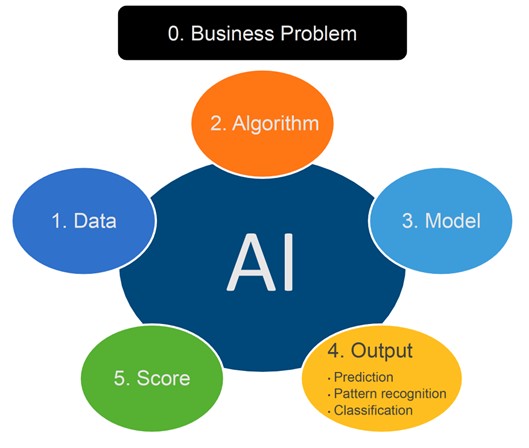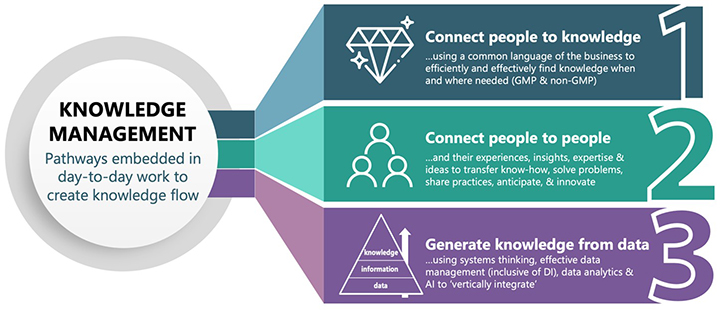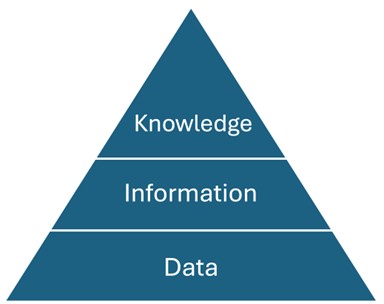Uncovering the Symbiotic Link Between KM and AI

At recent PDA conferences, multiple questions have arisen about the connection between knowledge management (KM) and specific concepts such as data integrity, third-party management and artificial intelligence. To address these questions, the KM task force formed three separate work teams to delve into each topic in detail.
KM and artificial intelligence (AI) are associated with the nature of knowledge, learning and decision-making in organizations. While the terms KM and AI are not synonymous, current literature and marketing headlines can be confusing, and possibly misleading, as to how these two important concepts relate. This paper explores the basic concepts of both KM and AI, particularly the relationship between them.
AI Basics
What is AI and what does it do?
AI is a branch of computer science that uses algorithms, data and computational power to simulate human intelligence in machines. AI is a set of technologies that enables computers to perform a variety of advanced functions, including the ability to see (image recognition), understand and translate spoken and written language, analyze data, make recommendations, recognize patterns and relationships in data, and more (1).
On an operational level, for business use AI technologies are based primarily on machine learning (ML) and deep learning (see breakout box below). They can be used for various purposes including data analytics, predictions, forecasting, object categorization, natural language processing, recommendations and intelligent data retrieval (1). Through these new or enhanced capabilities, AI has the potential to revolutionize health care, including many aspects of pharmaceutical product development and manufacturing.
What is machine learning?
Machine learning is a branch of computer science that focuses on using data and algorithms to enable AI to imitate how humans learn, gradually improving AI’s accuracy (2).
What are neural networks?
A neural network is an ML program or model that makes decisions in a manner similar to the human brain. It uses processes that mimic the way biological neurons work together to identify phenomena, weigh options and arrive at conclusions (2).
What is deep learning?
Deep learning is a subset of ML that uses multilayered neural networks, called deep neural networks, to simulate the complex decision-making power of the human brain. Some forms of deep learning power many of the AI applications in our lives today (2).
What is natural language processing?
Natural language processing is a subfield of computer science and AI that uses ML to enable computers to understand and communicate using human language (2).
Recent breakthroughs in AI have led to much hype about its potential to transform business as we know it today. While AI is currently a fixture of news headlines and marketing materials, many AI applications trace back to the 1950s, including optical character recognition (OCR) and language translation capabilities. We interact with many AI-powered capabilities daily, including:
- Optical character recognition: A technology that converts text from images, most often scanned documents, into machine-readable text.
- Spell-checking: Microsoft tools, Grammarly, and other applications use natural language processing (NLP) and ML to analyze text and identify errors. The application compares the text to a database of grammar and spelling rules and can also understand context.
- Personalized recommendations: Streaming services, such as Netflix (3), Spotify and YouTube use AI to suggest movies, songs and videos based on your viewing history.
- Virtual assistants: Smart speakers, including devices like Alexa, Siri and Google Assistant use NLP to understand and respond to your voice commands.
- Spam filters: Email and messaging applications use AI algorithms to analyze emails and messages to identify and filter out spam.
- Facial recognition: Many smartphones use facial recognition to unlock the device or authenticate payments.
- Websites and Applications: Many companies use AI-powered chatbots to provide customer support and answer common questions.
AI is a very broad concept, and its technologies offer a powerful set of capabilities for which an incredibly diverse set of use cases will only grow over time.
How does AI work?
As outlined by Tony Manzano at the PDA-FDA Joint Regulatory Conference, AI consists of “three ingredients + secret sauce” to emulate human intelligence—those ingredients being software, power computing and math, and the secret sauce being the use of good data (4). Manzano further described the five basic concepts in AI (Figure 1).
- Data (training and test): The problem dataset
- Algorithm: Mathematical procedure that creates the model from training data
- Model: Mathematical system that has been created from the exploration of a dataset, created after an extensive learning process by the model, referred to as training
- Output: For example, results in the form of a prediction, classification, recommendation, recognition or dimension reduction; a single inference from a model with an unseen sample as an input (e.g., the corrected spelling, movie recommendation, successful facial scan)
- Score: Score evaluation of the test dataset (i.e., evaluation of the accuracy of the resulting output)

This is a cyclical process that repeats with refinements to the model until the score (i.e., accuracy of the output) is deemed acceptable for its intended application.
Notably, underlying terminology, concepts and techniques quickly become complex. Gartner provides a summary, AI Techniques Framework (5), that includes AI domains, with associated example technique(s), of:
- Probabilistic reasoning (e.g., ML, predictive modeling)
- Computational logic (e.g., rule-based systems)
- Optimization techniques (e.g., constraint satisfaction, constraint-based reasoning)
- NLP (e.g., natural language generation, chatbots)
- Knowledge representation, learning and search (e.g., knowledge graphs, semantic networks, advanced digital twins)
- Agent-based computing/orchestration
- Perception systems/ambient Intelligence (e.g., computer vision)
- Smart process automation and smart robotic systems
Notably, a complete AI solution might exist as one of the above techniques, but often it is a composite solution employing multiple techniques (e.g., knowledge graphs and NLP).
How is AI beneficial?
AI offers many capabilities in the form of potential outputs as described above, such as probabilistic reasoning, optimization techniques and automation. Potential benefits could include data mining and extraction, proactive identification of potential quality issues (predictive analytics), process optimization, better understanding of process variability and complexity, real-time monitoring, drug discovery and development, clinical trials optimization, personalized medicine, regulatory compliance and documentation, supply chain optimization, continuous learning and knowledge-sharing, and more. AI is “always on,” can automate repetitive tasks and processes and can quickly handle large volumes of data to derive previously unseen insights.
What are the risks and challenges with AI?
AI is a rapidly evolving field of computer science. The potential impacts to both business and our daily lives across the many domains of AI are in their infancy. Pertinent to the context of this paper, however, there are several often-cited challenges with AI. Most relevant is the quality of data. This “data” is often data in the traditional sense, for example, process or laboratory data. But this data can also be in the form of what might be called information or knowledge, for example, documents, online discussions and such discrete items as lessons and report findings. Furthermore, such “data” can extend to include associated descriptive data (i.e., metadata), such as who the author of the document is.
Another common challenge is the size of the dataset necessary to train the AI model. The size of the required dataset varies greatly based on the AI technique applied and accuracy of the desired outcome; the simplest AI applications (e.g., clustering) require 50-100 labeled training examples, and more advanced applications require 10,000, 100,000 or more. Certain types of large language models, such as ChatGPT, are trained on billions of words over months to years.
Considering ethical and regulatory factors while implementing AI solutions in this highly sensitive and regulated sector is essential.
KM Basics
What is KM and what does it do?
KM is defined in the | International Council for Harmonization Quality Guideline Q10: Pharmaceutical Quality Systems as a “systematic approach to acquiring, analyzing, storing, and disseminating information related to products, manufacturing processes, and components” (6). Arguably, given the broader context of ICH Quality Guidelines, the scope intended by this definition begins with the acquisition of data and continues through to how knowledge derived from data is applied towards an outcome in support of the pharmaceutical quality system, for example, to inform risk management activities or support risk-based decision-making (7). Importantly, the cross-ICH-guideline references to KM include not only sources of data, but also set expectations for experience, expertise, know-how and other tacit knowledge to be judiciously applied in risk assessments, decision making, investigations, and other contexts.
Other authoritative, industry-agnostic definitions of KM include that from ISO 30401:2018 Knowledge management systems – Requirements, “Management with regard to knowledge, (i) using a systemic and holistic approach to improve results and learning; (ii) includes optimizing the identification, creation, analysis, representation, distribution & application of knowledge to create organizational value” (8), and from the APQC Knowledge Management Glossary, “A collection of systematic approaches to help knowledge flow to and between the right people at the right time (in the right format at the right cost) so they can act more efficiently and effectively to create value for the organization” (9).

KM, first and foremost, is a pivotal enabler to the goals of a modern pharmaceutical quality system, alongside effective quality risk management. However, KM has many proven benefits beyond product quality, including operational benefits (business effectiveness and efficiency), people (productivity, engagement, development) and in support of business transformation goals (e.g., digital transformation) (10).
One framework suggests three required pathways that need to be addressed in a holistic approach to KM: (i) connect people to knowledge, (ii) connect people to people, and (iii) generate knowledge from data (10) (see Figure 2).
How does KM work?
In contrast to AI, KM is not a technology but rather should be considered a set of business capabilities that enable effective management of knowledge. Each of these capabilities consists of elements of people (e.g., mindsets and behaviors to learn, manage knowledge as an important asset), process (e.g., standard steps to capture and share knowledge) and technology (where appropriate, to deploy and scale through technology, e.g., scientific search with supporting taxonomy).
There are many KM capabilities, often referred to as KM practices or KM approaches. Common KM capabilities include lessons learned, content management, taxonomy, search, communities of practice, best practice transfer and expertise location. These capabilities may exist in rudimentary form in organizations and, quite often, are not recognized as a KM practice. Some additional capabilities include product knowledge plans, risk assessment techniques such as “What If?” and techniques for critical knowledge retention when experts retire.
How is KM beneficial?
A helpful way to think about KM is how an organization understands the value of its knowledge, and what steps they have taken (via KM practices) to ensure this knowledge flows through the organization when and where it is needed. Commonly recognized benefits of KM include less time searching for documents, finding experts quickly, asking for help on a community forum and capturing lessons learned. There are a great many benefits possible, however, among them fewer deviations, faster problem resolution, more accurate risk assessments, right-first-time technology transfer, fewer repeat issues, improved control strategies (10).
What are the risks and challenges with KM?
KM is distinct from AI in this regard: While AI is an emerging and complex technology, sometimes powered by a perceived “black box” (i.e., the algorithm and model may not be transparent in how they work and derive outcomes), KM starts with a set of business processes and behavioral norms. As such, the key challenges associated with KM are typically organizational, such as the ability to define and remain compliant with standard work practices and the organizational change management associated with getting the workforce to adopt new ways of working. Indeed, KM does not introduce new risk in the same manner as AI, but not employing KM could lead to risk!
AI for KM: AI as a Catalyst to Create New Knowledge and Improve Knowledge Flow
The three pathways proposed in Figure 2 provide a helpful construct to examine the relationship between AI and KM, starting with Path 3 — generate knowledge from data. An oft-cited framework for the connection between data and knowledge is the data-information-knowledge pyramid (see Figure 3). The concept of “wisdom” is often found at the top of this pyramid in literature, but it is more tangible to consider this as the “understanding” to take action or make a decision.
Likewise, there are many sources in literature that describe the progression up the pyramid — or, perhaps, more intentionally, the “vertical integration.” Figure 4 is a depiction of the pyramid with further description of each tier and summary-level steps to progress from “data to information” and “information to knowledge” (12, 13). Importantly, not every detail or requirement is depicted in Figure 4. For example, sound data management practices are required to ensure the desired data is collected to begin with, along with other requirements of data quality and data integrity. (see PDA Letter series on Knowledge Management and its Relation to Data Integrity.) These particular topics, and the connection between data quality and data integrity with KM, are the subject of another paper by this PDA Task Force.


Given this framework in Figure 4, the role of KM is multifold, including to (i) ensure that both the explicit and tacit knowledge of the organization is available on demand for use; (ii) ensure new knowledge is captured from all relevant sources (e.g., results of data analysis activities, effective content management, knowledge from reflections such as lessons learned); and (iii) ideally, ensure all of the elements are in place and coordinated to “vertically integrate” the pyramid in Figure 4.
AI capabilities can contribute to this “vertical integration” in a number of ways. Perhaps most visible is the ability to generate new knowledge — whether doing so faster (perhaps even real-time) or by finding new insights and patterns previously unseen in or across data and information sets. As such, AI can be a catalyst to “vertically integrate.” In fact, there are opportunities for AI to help each activity within the KM lifecycle, including knowledge creation, knowledge storage and retrieval, knowledge-sharing and knowledge application (14).
Another case for how AI can catalyze KM — in large part supporting Pathways 1 and 2 in Figure 2 — is in how it helps KM do better what KM is already working to do. AI offers many powerful features that can play a role in the semantic layer (see breakout below) of the organization, from categorization (e.g., auto-tagging of documents), to NLP-powered search (“did you mean…”), to filtering and prioritizing search results, to personalization of knowledge portals, to proactively routing lessons learned based on similar work, and much more (15). A simple but tangible example is OCR, which has been in use for many years: paper documents scanned with OCR (AI) can then become discoverable, tagged and full-text searchable in an organization’s search tools (KM with support from information technology). Another example is the insights that can be gained using AI to integrate across many disparate sources of textual data, from online discussion forums regarding key manufacturing topics to make visible reoccurring themes and predictions.
What is semantics in technology?
In technology, semantics refers to the concepts and ideas that underlie the meaning of data, words, and concepts. Semantic technology is a set of tools and methods that use semantics to process and categorize data, and to discover relationships within data sets (16).
What is a semantic layer?
A semantic layer is a standardized framework that organizes and abstracts organizational data (structured, unstructured, semi-structured) and serves as a data connector for data and knowledge. It allows organizations to represent organizational knowledge and domain meaning to systems and applications, defining the relationship between content and data. Specifically, a semantic layer:
- Makes data available for both humans and machines to understand
- Captures and connects content and data based on business or domain meaning and value
- Aggregates and unifies unstructured and structured data to connect data of all formats
- Enables data federation and virtualization (17)
KM for AI: Building Credibility and Trust while Avoiding “Information Overload”
The information on which an AI model is trained has a significant impact on its trustworthiness and performance. An under-appreciated element of AI deployments is the critical enabling role KM must play in providing a trusted, accurate, up-to-date, well-organized base of data, information and knowledge from which AI is trained (13).
According to McKinsey, more than 80% of organizations are investing in AI but only 21% of firms are able to adopt AI at scale (18). The primary challenge is the lack of clear strategies for sourcing the knowledge that AI requires from the organization and its data. This is where KM is becoming more visible.
KM can play a role in establishing the knowledge architecture for organizations, whether broadly (e.g., enterprise rules and governance for SharePoint, regulated content management and other repositories) or, at the very least, defining at a product level the critical knowledge, knowing where it is and enabling it to flow to the decision-maker — be that “people intelligence” or “artificial intelligence.” Proactively defining and connecting KM and data management strategies will enable organizations to derive more value from AI much more quickly.
Conclusion
AI offers the pharmaceutical industry potentially transformative capability and a long list of exciting new benefits. KM is a core requirement in the pharmaceutical industry that the industry is still working to evolve, and organizations that mature in KM will have a significantly better return on AI investments. Understanding the symbiotic relationship between these two emerging disciplines and advancing both AI and KM forward together will drive the best overall shared success for patients and industry organizations alike.
References
- Google Cloud, “What is Artificial Intelligence (AI)?” Accessed: Oct. 01, 2024. [Online]. Available: https://cloud.google.com/learn/what-is-artificial-intelligence.
- IBM, “Explainers.” Accessed: Oct. 01, 2024. [Online]. Available: https://www.ibm.com/topics.
- Netflix, “How Netflix’s Recommendations System Works.” Accessed: Oct. 01, 2024. [Online]. Available: https://help.netflix.com/en/node/100639#:~:text=We%20take%20feedback%20from%20every,how%20you%20rate%20those%20titles.
- T. Manzano, “AI in drug manufacturing: understanding manufacturing processes from a GxP perspective,” in PDA-FDA Joint Regulatory Conference 2023, Washington DC, Sep. 2023.
- Gartner, “What Is Artificial Intelligence?” Accessed: Oct. 01, 2024. [Online]. Available: https://www.gartner.com/en/topics/artificial-intelligence.
- International Council on Harmonisation, Quality Guideline Q10: Pharmaceutical Quality System. Geneva, 2008. [Online]. Available: https://database.ich.org/sites/default/files/Q10 Guideline.pdf.
- V. Mulholland, A. Greene, and M. J. Lipa, “Improving Risk-Based Decision Making Effectiveness: Addressing Uncertainty,” KENX Insight, Vol. 3, No. April, pp. 1–12, 2023, [Online]. Available: https://kenx.org/kenx_insights/improving-risk-based-decision-making-effectiveness-addressing-uncertainty/.
- ISO, ISO 30401:2018 Knowledge management systems – Requirements, Geneva, 2018. [Online]. Available: https://www.iso.org/standard/68683.html.
- APQC, Knowledge Management Glossary. Houston, TX: APQC, 2019. [Online]. Available: https://www.apqc.org/resource-library/resource-listing/knowledge-management-glossary.
- M. J. Lipa, “Operationalizing KM,” in PDA/FDA Joint Regulatory Conference 2024, Sep. 2024.
- J. Rowley, “The wisdom hierarchy: representations of the DIKW hierarchy,” J Inf Sci, Vol. 33, No. 2, pp. 163–180, 2007, doi: 10.1177/0165551506070706.
- K. O’Donnell, M. J. Lipa, and A. Greene, “Taking a Stand for Quality: Demonstrating PQS Effectiveness by Operationalising QRM and KM,” Journal of Applied Pharmaceutical Regulatory Science, Vol. 1, No. 3, Dec. 2024, Accessed: Oct. 01, 2024. [Online]. Available: https://arrow.tudublin.ie/japrs/vol1/iss3.
- M. O’Mahony, et al., “FoReSight: Trusting and Using the Information from Data Analytics to Support Decision-Making in Pharmaceutical Analytics to Support Decision-Making in Pharmaceutical Manufacturing,” Journal of Applied Pharmaceutical Regulatory Sciences, Vol. 1, No. 1, Apr. 2024, [Online]. Available: https://arrow.tudublin.ie/japrs.
- M. H. Jarrahi, D. Askay, A. Eshraghi, and P. Smith, “Artificial intelligence and knowledge management: A partnership between human and AI,” Bus Horiz, vol. 66, no. 1, pp. 87–99, Jan. 2023, doi: 10.1016/j.bushor.2022.03.002.
- A. Lane, “The Role of AI in the Semantic Layer,” Enterprise Knowledge, May 29, 2024. Accessed: Oct. 01, 2024. [Online]. Available: https://enterprise-knowledge.com/the-role-of-ai-in-the-semantic-layer/
- Base22, LLC, “What are Semantic Technologies?” Accessed: Oct. 01, 2024. [Online]. Available: https://base22.com/what-is-semantic-technology/#:~:text=Semantic%20technology%20is%20a%20modern,for%20the%20future%20of%20business.
- L. Tesfaye, “What is a Semantic Layer?” Enterprise Knowledge, Feb. 1, 2024. Accessed: Oct. 01, 2024. [Online]. Available: https://enterprise-knowledge.com/what-is-a-semantic-layer-components-and-enterprise-applications/.
- McKinsey & Company, “AI adoption advances, but foundational barriers remain,” Nov. 13, 2018. Accessed: Oct. 01, 2024. [Online]. Available: https://www.mckinsey.com/featured-insights/artificial-intelligence/ai-adoption-advances-but-foundational-barriers-remain







